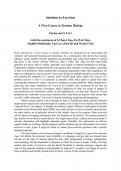Exam (elaborations)
Solutions to Exercises A First Course in Systems Biology EBERHARD O. VOIT (with the assistance of I-Chun Chou, Po-Wei Chen, Sepideh Dolatshahi, Yun Lee, Zhen Qi and Weiwei Yin)
- Course
- Institution
Solutions to Exercises A First Course in Systems Biology EBERHARD O. VOIT (with the assistance of I-Chun Chou, Po-Wei Chen, Sepideh Dolatshahi, Yun Lee, Zhen Qi and Weiwei Yin)
[Show more]



